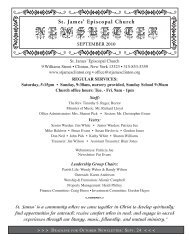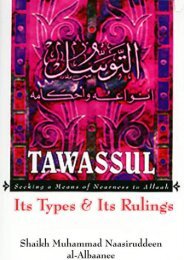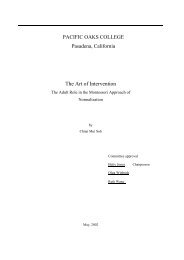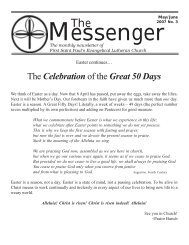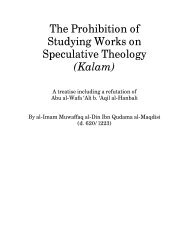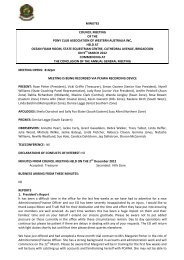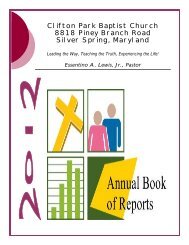Scripture and God in Christianity
Scripture and God in Christianity
Scripture and God in Christianity
You also want an ePaper? Increase the reach of your titles
YUMPU automatically turns print PDFs into web optimized ePapers that Google loves.
emerged out of particular "liv<strong>in</strong>g situation" (Sitz im Leben) they already had beh<strong>in</strong>d them a history<br />
which had helped to shape them, had already been passed on as the message of Jesus. The<br />
evangelists- undoubtedly not merely collectors <strong>and</strong> transmitters, as people once thought, but absolutely<br />
orig<strong>in</strong>al theologians with their own conception of the message- arranged the Jesus narratives<br />
<strong>and</strong> Jesus say<strong>in</strong>gs accord<strong>in</strong>g to their own plan <strong>and</strong> at their own discretion... The evangeliststhemselves<br />
certa<strong>in</strong>ly active engaged <strong>in</strong> missionary work <strong>and</strong> <strong>in</strong> catechiz<strong>in</strong>g- arranged the traditional<br />
texts to suit the needs of their communities. They <strong>in</strong>terpreted them <strong>in</strong> the light of the Easter<br />
events, exp<strong>and</strong>ed them <strong>and</strong> adapted them where they thought it necessary. Hence, despite all their<br />
common features, the different Gospels each acquired a different profile of the one Jesus." 50<br />
John Hick puts the po<strong>in</strong>t <strong>in</strong> a nutshell: "None of the writers was an eye-witness of the life that<br />
they depict. The Gospels are secondary <strong>and</strong> tertiary portraits dependent on oral <strong>and</strong> written traditions<br />
which had developed over a number of decades, the orig<strong>in</strong>al first-h<strong>and</strong> memories of Jesus<br />
be<strong>in</strong>g variously preserved, w<strong>in</strong>nowed, developed, distorted, magnified <strong>and</strong> overlaid through the<br />
<strong>in</strong>terplay of many factors <strong>in</strong>clud<strong>in</strong>g the universal tendency <strong>in</strong>creas<strong>in</strong>gly to exalt one's leaderfigure,<br />
the delight of the ancient world <strong>in</strong> the marvelous, opposition to the ma<strong>in</strong>stream of Judaism<br />
from which the church had now been separated, an <strong>in</strong>tensification of faith under persecution,<br />
factional polemics with<strong>in</strong> different streams of the Christian community itself, <strong>and</strong> a policy of present<strong>in</strong>g<br />
events <strong>in</strong> Jesus' life as fulfillments of ancient prophecy or as exemplify<strong>in</strong>g accepted religious<br />
themes." 51 Clearly, argues Hick, "the attempt to form a picture of the life that lay forty to<br />
sixty or seventy years beh<strong>in</strong>d the written Gospels cannot yield a great deal <strong>in</strong> the way of fully assured<br />
results." 52 Howard Kee observes, that unlike our times the historians <strong>and</strong> writers of the first<br />
century, "were not <strong>in</strong>terested simply <strong>in</strong> report<strong>in</strong>g events of the past, but saw their role as provid<strong>in</strong>g<br />
the mean<strong>in</strong>g of those past events for readers <strong>in</strong> the present." 53 Therefore, dur<strong>in</strong>g these sixty<br />
years or so, the Gospels were developed, <strong>in</strong> the words of Paula Fredricksen, "from oral to written;<br />
from Aramaic to Greek; from the End of time to the middle of time; from Jewish to Gentile;<br />
from Galilee <strong>and</strong> Judea to the Empire..." 54<br />
From the facts like these of oral transmission, Easter experience, missionary zeal, <strong>and</strong> compilation<br />
of Jesus's say<strong>in</strong>gs after a period of 30 to 60 years, many modern scholars doubt the authenticity<br />
<strong>and</strong> <strong>in</strong>tegrity of most of the New Testament books. Ernst Kaesemann argues, that "the <strong>in</strong>dividual<br />
say<strong>in</strong>gs <strong>and</strong> stories it must be said that from their first appearance they were used <strong>in</strong> the<br />
service of the community's preach<strong>in</strong>g <strong>and</strong> were <strong>in</strong>deed preserved for the very reason. It was not<br />
historical but kerygmatic <strong>in</strong>terest which h<strong>and</strong>ed them on. From this st<strong>and</strong>po<strong>in</strong>t it becomes comprehensible<br />
that this tradition, or at least the overwhelm<strong>in</strong>g mass of it, cannot be called authentic.<br />
Only a few words of the Sermon on the Mount <strong>and</strong> of the conflict with the Pharisees, a number<br />
of parables, <strong>and</strong> some scattered material of various k<strong>in</strong>ds go back with any real degree of probability<br />
to the Jesus of history...The preach<strong>in</strong>g about him has almost entirely supplanted his own<br />
preach<strong>in</strong>g, as can be seen most clearly of all <strong>in</strong> the completely unhistorical Gospel of John." 55<br />
John Hick claims that, "The identifiable consensus beg<strong>in</strong>s with a dist<strong>in</strong>ction between the historical<br />
Jesus of Nazareth <strong>and</strong> the post-Easter development of the church's m<strong>in</strong>gled memories <strong>and</strong> <strong>in</strong>terpretations<br />
of him. And it is a basic premise of modern New Testament scholarship that we<br />
have access to the former only through the latter." 56<br />
7





